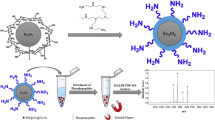Abstract
Magnetite (Fe3O4) nanoparticles provide several possibilities for a compelling platform for medical applications due to their magnetic properties. In the same way, functionalization with polymers provides several properties seeking to achieve colloidal stabilization in physiological fluids. Nonetheless, the use of magnetite nanoparticles as a medical agent is still in its early stages and is faced with many doubts and challenges as the study of coatings interactions with biological molecules. In this work, Fe3O4 nanoparticles were synthetized by co-precipitation method and further coated with chitosan, as well as coated with polyethyleneimine. The nanoscale size of magnetite nanoparticles was confirmed using scanning electron microscopy. Fourier-transform infrared spectroscopy corroborated that characteristic functional groups of chitosan and polyethylenimine were present in the surface modified magnetite samples. The evaluation of protein immobilization was carried out by incubating bovine serum albumin at different concentrations followed by magnetic decantation using a permanent magnet. Coated magnetite nanoparticles have a protein absorption greater than bare MNP.
Graphical abstract





Similar content being viewed by others
Data availability
The datasets generated during and/or analyzed during the current study are available from the corresponding author on reasonable request.
References
I. Astefanoaei, A. Stancu, Optimal control of the hyperthermic thermal damage within intravascular tumoral regions. J. Magn. Magn. Mater. 537, 168221 (2021). https://doi.org/10.1016/J.JMMM.2021.168221
A. Kale et al., Magnetite/CdTe magnetic-fluorescent composite nanosystem for magnetic separation and bio-imaging. Nanotechnology (2011). https://doi.org/10.1088/0957-4484/22/22/225101
S. Zarei, S. Sadighian, K. Rostamizadeh, M. Khalkhali, Theragnostic magnetic core–shell nanoparticle as versatile nanoplatform for magnetic resonance imaging and drug delivery. Biointerface Res. Appl. Chem. 11(5), 13276–13289 (2021). https://doi.org/10.33263/BRIAC115.1327613289
M.S. Perdani et al., Immobilization of cholesterol oxidase in chitosan magnetite material for biosensor application. Int. J. Technol. 11(4), 754 (2020). https://doi.org/10.14716/IJTECH.V11I4.3484
J.A. Roacho-Perez, H.L. Gallardo-Blanco, M. Sanchez-Dominguez, P. Garcia-Casillas, C. Chapa-Gonzalez, C.N. Sanchez-Dominguez, Nanoparticles for death-induced gene therapy in cancer. Mol. Med. Rep. 17(1), 1413–1420 (2018). https://doi.org/10.3892/mmr.2017.8091
S. Hooshmand, S.M.G. Hayat, A. Ghorbani, M. Khatami, K. Pakravanan, M. Darroudi, Preparation and applications of superparamagnetic iron oxide nanoparticles in novel drug delivery systems: an overview. Curr. Med. Chem. 28(4), 777–799 (2020). https://doi.org/10.2174/0929867327666200123152006
J.A. Roacho-Pérez et al., A full set of in vitro assays in chitosan/tween 80 microspheres loaded with magnetite nanoparticles. Polymers 13(3), 1–15 (2021). https://doi.org/10.3390/POLYM13030400
E. Piosik, P. Klimczak, M. Ziegler-Borowska, D. Chełminiak-Dudkiewicz, T. Martyński, A detailed investigation on interactions between magnetite nanoparticles functionalized with aminated chitosan and a cell model membrane. Mater. Sci. Eng. C 109, 110616 (2020). https://doi.org/10.1016/J.MSEC.2019.110616
L. León Félix, M.A. Rodríguez Martínez, D.G. Pacheco Salazar, J.A. Huamani Coaquira, One-step synthesis of polyethyleneimine-coated magnetite nanoparticles and their structural, magnetic and power absorption study. RSC Adv. 10(68), 41807–41815 (2020). https://doi.org/10.1039/D0RA08872B
S. Chaleawlert-Umpon, N. Pimpha, Morphology-controlled magnetite nanoclusters via polyethyleneimine-mediated solvothermal process. Mater. Chem. Phys. 135(1), 1–5 (2012). https://doi.org/10.1016/J.MATCHEMPHYS.2012.03.111
V.S. Zaitsev, D.S. Filimonov, I.A. Presnyakov, R.J. Gambino, B. Chu, Physical and chemical properties of magnetite and magnetite-polymer nanoparticles and their colloidal dispersions. J. Colloid Interface Sci. 212(1), 49–57 (1999). https://doi.org/10.1006/JCIS.1998.5993
M. Khalkhali, K. Rostamizadeh, S. Sadighian, F. Khoeini, M. Naghibi, M. Hamidi, The impact of polymer coatings on magnetite nanoparticles performance as MRI contrast agents: a comparative study. DARU J. Pharm. Sci. 23(1), 1–12 (2015). https://doi.org/10.1186/S40199-015-0124-7
L. Zhao, M. Skwarczynski, I. Toth, Polyelectrolyte-based platforms for the delivery of peptides and proteins. ACS Biomater. Sci. Eng. 5(10), 4937–4950 (2019). https://doi.org/10.1021/ACSBIOMATERIALS.9B01135
P. Patel, N.M. Ibrahim, K. Cheng, The importance of apparent pKa in the development of nanoparticles encapsulating siRNA and mRNA. Trends Pharmacol. Sci. 42(6), 448–460 (2021). https://doi.org/10.1016/J.TIPS.2021.03.002
C. Chapa González, J.U. Navarro Arriaga, P.E. García Casillas, Physicochemical properties of chitosan–magnetite nanocomposites obtained with different pH. Polym. Polym. Compos. (2021). https://doi.org/10.1177/09673911211038461
R.V. Benjaminsen, M.A. Mattebjerg, J.R. Henriksen, S.M. Moghimi, T.L. Andresen, The possible ‘Proton Sponge’ effect of polyethylenimine (PEI) does not include change in lysosomal pH. Mol. Ther. 21(1), 149–157 (2013). https://doi.org/10.1038/MT.2012.185
K.A. Curtis, D. Miller, P. Millard, S. Basu, F. Horkay, P.L. Chandran, Unusual salt and pH induced changes in polyethylenimine solutions. PLoS ONE 11(9), e0158147 (2016). https://doi.org/10.1371/JOURNAL.PONE.0158147
C.E. Gallops, C. Yu, J.D. Ziebarth, Y. Wang, Effect of the protonation level and ionic strength on the structure of linear polyethyleneimine. ACS Omega 4(4), 7255–7264 (2019). https://doi.org/10.1021/ACSOMEGA.9B00066
H. Sadeghpour et al., Double domain polyethylenimine-based nanoparticles for integrin receptor mediated delivery of plasmid DNA. Sci. Rep. 8(1), 1–12 (2018). https://doi.org/10.1038/s41598-018-25277-z
F. Nouri, H. Sadeghpour, R. Heidari, A. Dehshahri, Preparation, characterization, and transfection efficiency of low molecular weight polyethylenimine-based nanoparticles for delivery of the plasmid encoding CD200 gene. Int. J. Nanomed. 12, 5557–5569 (2017). https://doi.org/10.2147/IJN.S140734
Acknowledgments
The authors thank the NANOMEDICINA-UACJ research group for their constant support and feedback at all stages of this research.
Author information
Authors and Affiliations
Corresponding author
Ethics declarations
Conflict of interest
The authors declare that there is no conflict of interest.
Rights and permissions
About this article
Cite this article
Chapa-González, C., Sosa, K.V., Roacho-Pérez, J.A. et al. Adsorption of serum protein in chitosan-coated and polyethyleneimine-coated magnetite nanoparticles. MRS Advances 6, 913–917 (2021). https://doi.org/10.1557/s43580-021-00153-7
Received:
Accepted:
Published:
Issue Date:
DOI: https://doi.org/10.1557/s43580-021-00153-7




